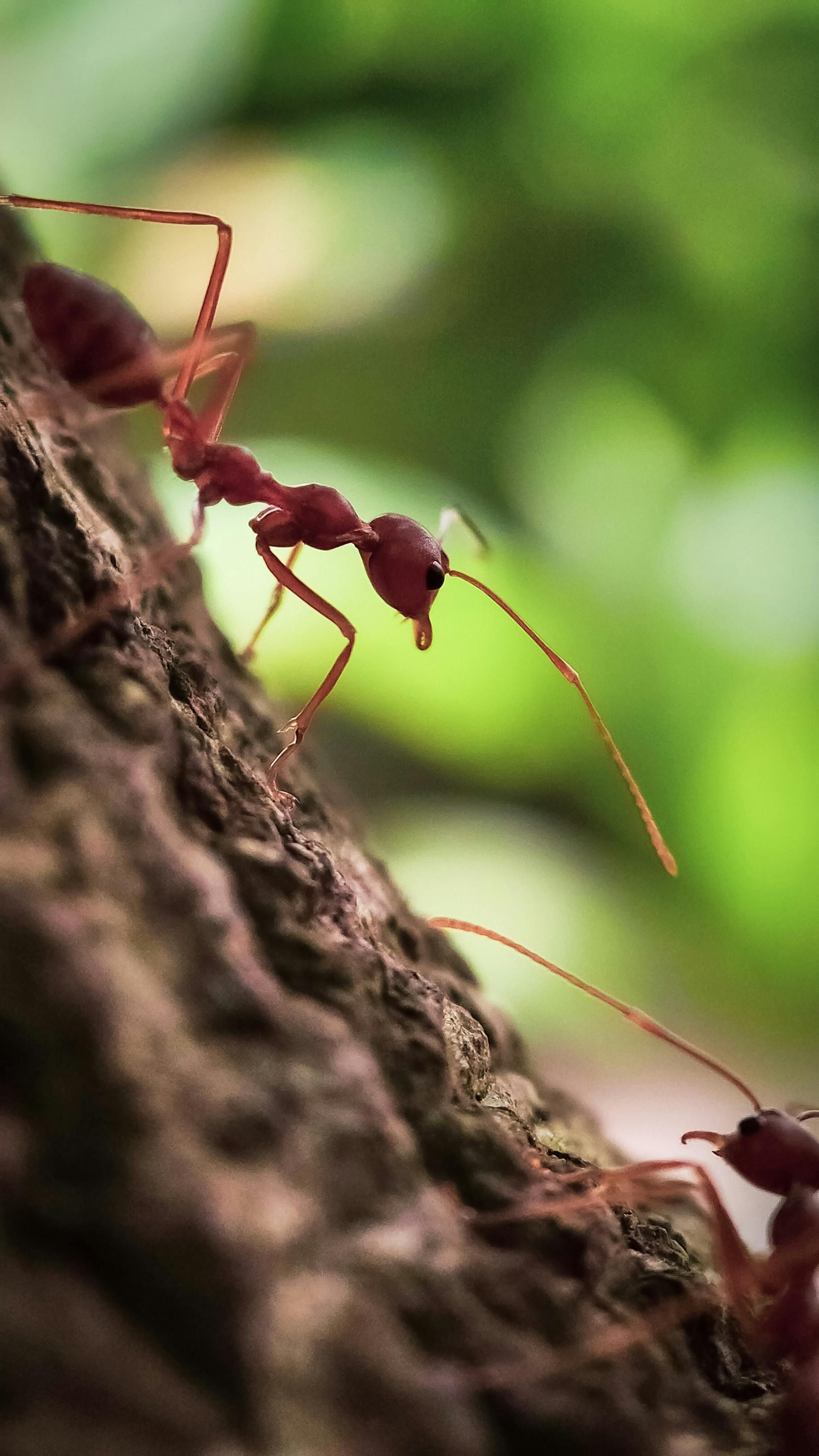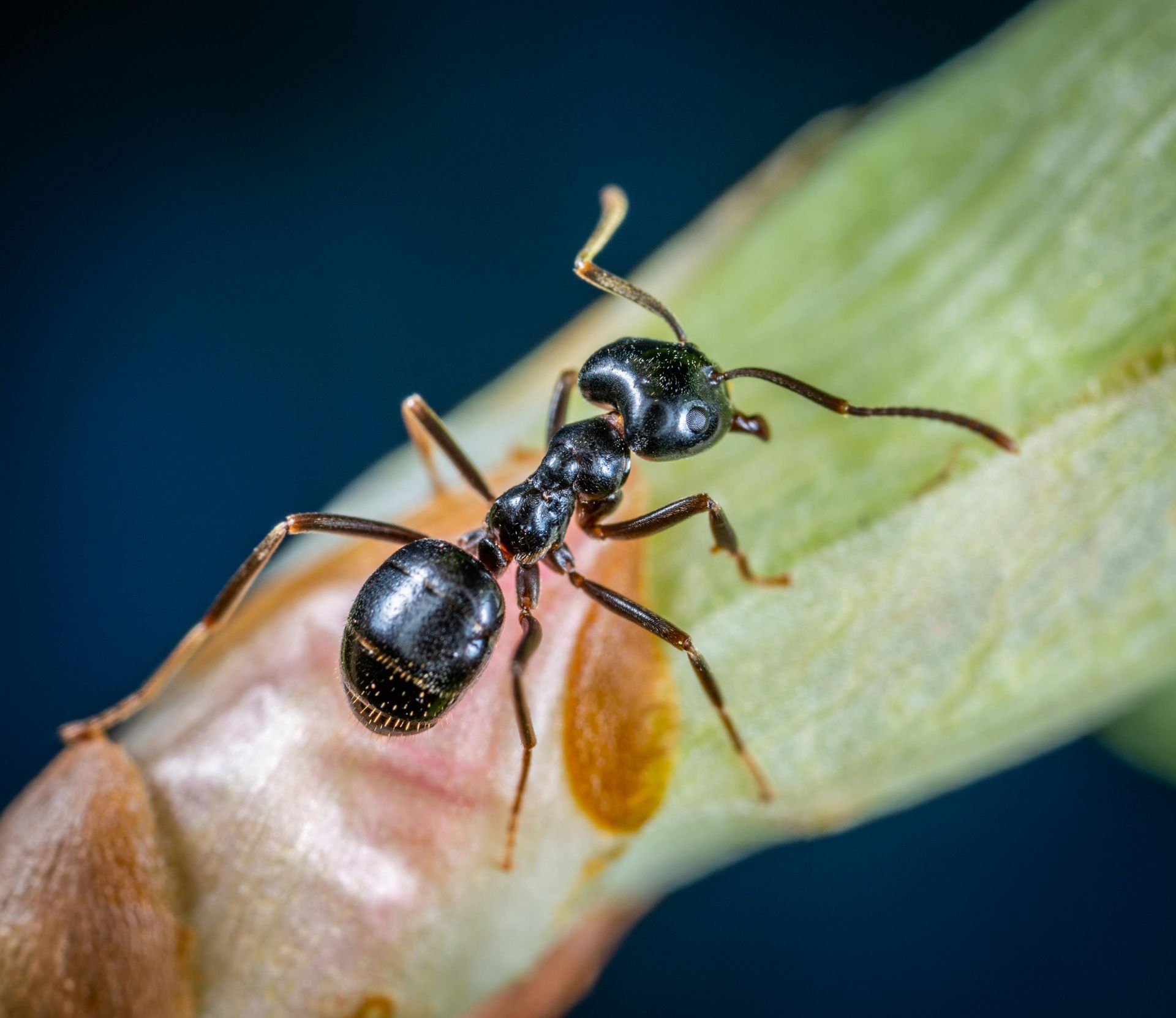Ants
Ants are small, social insects with a three-part body structure and elbowed antennae. They live in organized colonies, ranging from a few dozen to millions of individuals, and have roles like workers, soldiers, and reproductive members.
Found almost everywhere except Antarctica, ants are adaptable omnivores that use chemical signals, or pheromones, to communicate and coordinate activities like foraging and nest defense. While they play beneficial roles in ecosystems, some species can become pests when they invade human habitats.
Understanding the Various Types of Ants: A Guide to Identifying Common Household Invaders
These ants can enter homes for a variety of reasons, including the search for food, water, and shelter. Proper identification is key to effectively managing and controlling ant infestations in homes.
1. Odorous House Ants (Tapinoma sessile)
- Appearance: Small, brown to black ants about 1/16 to 1/8 inch long.
- Behavior: Known for their "rotten coconut" smell when crushed. They nest in wall voids, under floors, and near moisture sources.
- Habitat: Often found in kitchens and bathrooms.
2. Argentine Ants (Linepithema humile)
- Appearance: Light to dark brown ants, about 1/8 inch long.
- Behavior: They form massive colonies and are very aggressive toward other ant species. They travel in long trails, especially around food sources.
- Habitat: Commonly found near water sources, such as sinks, pipes, and bathrooms.
3. Carpenter Ants (Camponotus spp.)
- Appearance: Large ants, ranging from 1/4 to 1/2 inch long, usually black or red and black.
- Behavior: They hollow out wood to build their nests, which can cause structural damage. They do not eat wood but are attracted to moisture-damaged wood.
- Habitat: Nest in wall voids, hollow doors, window frames, and other wooden structures, especially in damp or decaying wood.
4. Pavement Ants (Tetramorium caespitum)
- Appearance: Small, brown to black ants with fine lines on their heads and thorax, about 1/8 inch long.
- Behavior: They form visible trails and build nests in cracks in pavement, under stones, and along foundations.
- Habitat: Frequently found in basements, garages, and kitchens.
5. Pharaoh Ants (Monomorium pharaonis)
- Appearance: Very small, yellow to light brown ants, about 1/16 inch long.
- Behavior: They are notorious for nesting in hidden, inaccessible areas and can establish multiple colonies in one building. Known for spreading disease in healthcare settings.
- Habitat: Warm, humid areas near food and water sources, such as kitchens, bathrooms, and heating ducts.
6. Ghost Ants (Tapinoma melanocephalum)
- Appearance: Very small, pale or translucent legs and abdomen with a dark head and thorax, about 1/16 inch long.
- Behavior: Known for being difficult to see due to their small size and pale color. They nest in wall voids, behind baseboards, and in potted plants.
- Habitat: Prefers moist environments and can be found in kitchens and bathrooms.
7. Crazy Ants (Paratrechina longicornis)
- Appearance: Dark brown to black ants with long legs and antennae, about 1/8 inch long.
- Behavior: Named for their erratic, rapid movement. They can form large colonies with multiple queens.
- Habitat: Prefers moist environments, often found in electrical equipment, wall voids, and under flooring.
8. Acrobat Ants (Crematogaster spp.)
- Appearance: Small, about 1/8 inch long, light brown to black. They have a distinctive heart-shaped abdomen.
- Behavior: They get their name from their ability to raise their abdomen above their heads. They nest in moist areas and decaying wood.
- Habitat: Found in trees, in wall voids, and around window frames.
9. Fire Ants (Solenopsis spp.)
- Appearance: Reddish-brown ants, ranging from 1/8 to 1/4 inch long.
- Behavior: Known for their aggressive behavior and painful sting. They usually build mounds outside but can enter homes in search of food.
- Habitat: Typically outdoors, but can enter homes through cracks and crevices.
10. Little Black Ants (Monomorium minimum)
Appearance: Very small, black ants, about 1/16 inch long.
Behavior: Form large colonies and are often seen foraging in long trails. They prefer sugary foods.
Habitat: Nest in wall voids, under carpets, and in woodwork.

If you have any questions, here are a few of the frequently asked questions.
Ants are among the most common household pests, often causing homeowners frustration as they invade kitchens, bathrooms, and other living spaces.
To help you better understand and manage these persistent intruders, we’ve compiled a list of frequently asked questions about
ant control and prevention.

1. Why do I have ants in my home?
Ants enter homes in search of food, water, and shelter. Even the smallest crumbs or spills can attract them. They can also be drawn to pet food or hidden leaks, and once they find a source, they communicate with the colony to invade.
2. How can I prevent ants from coming back after treatment?
After professional treatment, maintain cleanliness by wiping down surfaces, storing food in sealed containers, and fixing leaks. Regularly check for and seal any cracks or entry points where ants might enter.
3. What types of ants are most common in homes?
Common indoor ants include carpenter ants, pavement ants, and odorous house ants. Each type has different nesting habits and control methods, making identification important for effective treatment.
4. Are over-the-counter ant baits effective?
Over-the-counter ant baits can sometimes be effective for minor infestations, but they often only target a small portion of the colony. Professional-grade treatments are designed to eliminate the entire colony, including the queen, for long-term control.
5. How long does it take to get rid of an ant infestation?
The time required to control an ant infestation depends on the size of the colony and the type of ant. Smaller infestations can be resolved in a few days, while larger, more established colonies may take a few weeks of consistent treatment and monitoring.
6. Are the treatments safe for pets and children?
Professional pest control services use treatments that are safe when applied correctly. We take precautions to ensure that the products are used in a way that minimizes risk to humans and pets. Always follow the pest control expert’s guidelines for safety.
7. What should I do if I find an ant nest in my yard?
If you find an ant nest outside, avoid disturbing it, as this can cause the ants to scatter and potentially invade your home. Instead, contact a pest control expert to identify the type of ant and apply the appropriate treatment to the nest.
8. Why do ants keep coming back after I’ve treated them?
If ants keep returning, it’s likely that the queen and the main colony have not been eliminated. Ants can also create satellite colonies, so it’s essential to use treatments that reach the source of the infestation, not just the visible ants.
9. What should I do if I see carpenter ants?
Carpenter ants can cause significant damage to wooden structures. If you see large, black ants or find wood shavings, it’s important to contact a professional immediately. They will locate the nest and treat it to prevent further damage to your property.
10. Can ants damage my home?
While most ants are more of a nuisance than a threat, carpenter ants can cause structural damage by hollowing out wood for nesting. Regular inspections and timely treatment are crucial to prevent this type of damage.
Ant control services for a hassle-free experience.
At GetLocal Services, our platform's transparent pest control pricing eliminates the need for price shopping. Our system provides you with the best price based on the experience and qualifications of our thoroughly vetted exterminators.
Our professional network members undergo a rigorous vetting process to ensure they meet our high standards. This guarantees that you receive top-quality service at a fair price, making your experience with us completely hassle-free.
Avoiding Annoying Sales Calls
One significant advantage of using GetLocal Services is avoiding the annoyance of multiple sales calls from vendors vying for your business.
Once you select an exterminator through our platform, you won’t be bombarded with follow-up calls from other vendors. This ensures a stress-free experience, allowing you to easily focus on resolving your ant problem.
If you are looking for an exterminator for ants, we have professionals in your neighborhood
If you’re facing an ant infestation, our local exterminators are here to help. We specialize in treating the specific types of ants in your area, using effective methods to eliminate the problem and prevent future issues. Contact us today to schedule an inspection and keep your home ant-free.
DELAWARE
FLORIDA
GEORGIA
NEW JERSEY
PENNSYLVANIA
NORTH CAROLINA

Money-Back Guarantee!
Unhappy with the service? We'll send another provider. Still unsatisfied? Our money-back guarantee will make it right.
GetLocal Hassle-Free Home Services
ARE YOU A HOME SERVICES PROFESSIONAL?
Partner with us to connect with homeowners who seek trusted professionals, boosting your visibility and reputation in your community.

SERVICES
TOP LOCAL SERVICE AREAS
- New Jersey
- North Carolina
- Florida
- Georgia
- Pennsylvania
- Delaware
- USA
JOIN OUR MAILING LIST
Sign up for home services tips and more
Join the Newsletter
We will get back to you as soon as possible
Please try again later
Copyright, GetLocal Services, LLC. | All Rights Reserved. | Terms of Use | Privacy Policy









